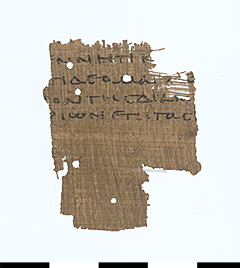BKT IX 42 (P. 21141)
Reason in the head, bravery in the heart, desire in the liver – the famous ancient physician Galen tries to build a bridge between Hippocratic medicine and Platonic philosophy. A small fragment from this great work has been preserved in the Berlin papyrus collection.
This small papyrus fragment with remnants of four lines on the front and five lines on the back belongs to the lower margin of a codex leaf from which further fragments have been preserved in the Bayerische Staatsbibliothek in Munich. The Berlin fragment can be directly matched to the Munich fragment. Due to the quite different state of preservation of the two fragments, it can be assumed that they were already separated in antiquity. Originally, it had a writing mirror on both sides, the height of which was twice as large as the width.
The codex leaf contains a copy of Galen’s writing „On the Doctrines of Hippocrates and Plato“ (chapters 88, 29-31 and 90, 20-22 on the Berlin fragment). Galen, a physician from Pergamon in Asia Minor, wrote this work in nine books between 162 and 176 AD in Rome. Based on his own comments on this work in other writings, we know that Galen wrote the first six books between 162 and 166 AD in Rome on behalf of the former consul and later governor of the Roman province of Syria Palaestina Titus Flavius Boethus, who had a great interest in his medical research. Galen accompanied him to his province. After his return in 169 AD, he wrote the last three books of this work.
It is interesting to note that the copy on the papyrus fragments in Berlin and Munich, which was found in the Middle Egyptian town of Ashmunein, the ancient Hermupolis, can be dated to the first half of the 3rd century AD on the basis of the hand-writing. This makes it one of the oldest records of a work by Galen and thus provides valuable clues to the original form of the text.
As a follower of the teachings of the great and famous Greek physician Hippocrates of Cos, Galen deals with his teachings in this work and compares them with the ideas about the nature of the soul of the Greek philosopher Plato. In doing so, Galen is not at all concerned with playing philosophy and medicine off against each other and proving the correctness of one discipline over the other. Rather, he shows that he agrees with the statements of the philosopher and the physician on all points. His aim is to prove that the statements of the physician Hippocrates and the philosopher Plato can agree. He tries to fit Plato’s rather abstract opinions quite concretely into human physiology, which for him is based on Hippocrates‘ ideas.
It is therefore not surprising that in the few remains that have survived on the papyrus fragments we can read Galen’s description of the arteries in the lower parts of the body and the legs, even if the connection to Plato’s metaphysical ideas must remain unclear because this text passage has no longer survived.
Galen claims in his other writings that his works were already read in many provinces of the Roman Empire during his lifetime. This may be an exaggeration and confirmation of his own pride. However, the fragments in Berlin and Munich come from the Roman Hermupolis in Middle Egypt and from a time shortly after the doctor’s death. They may therefore not necessarily confirm Galen’s statements. However, they do show that his works were not only received in the great cultural centres of the Roman world such as Rome, Alexandria, etc., but were also disseminated much further afield.
This papyrus with a part of Gale’s work was on display in the exhibition „Au temps de Galien. Un médicin grec dans l’empire romain“ at the Musée Royal de Mariemont in Morlanwelz in Belgium.



